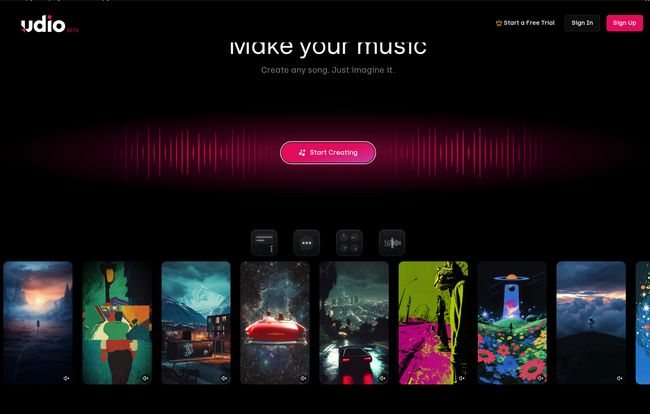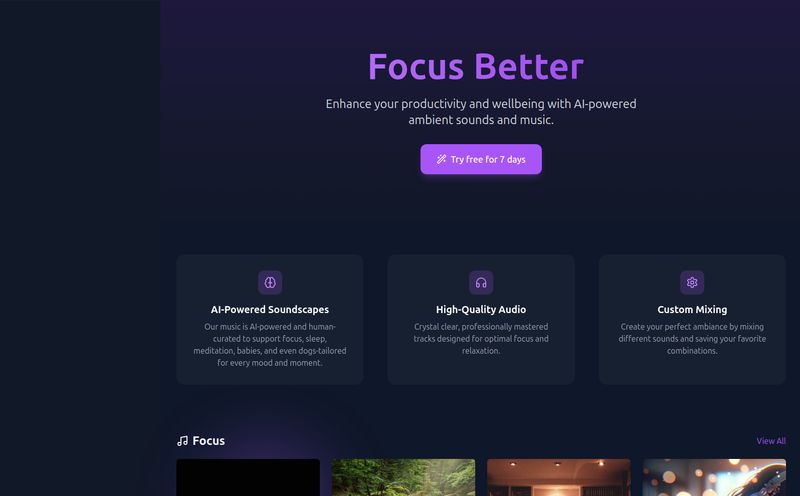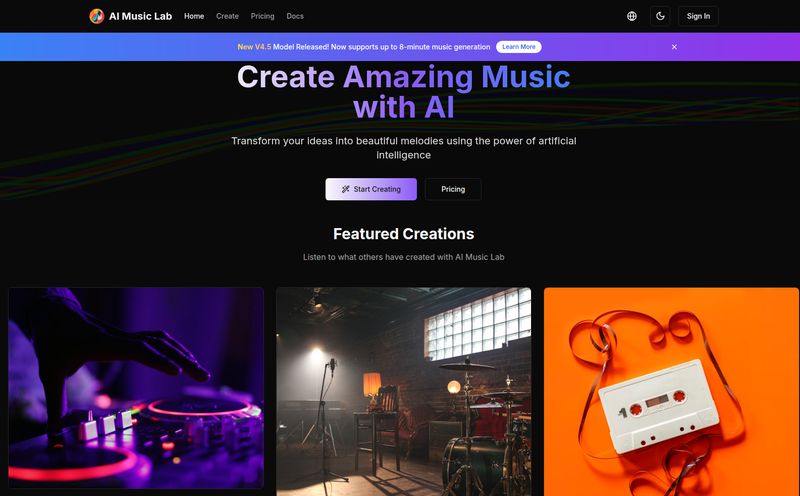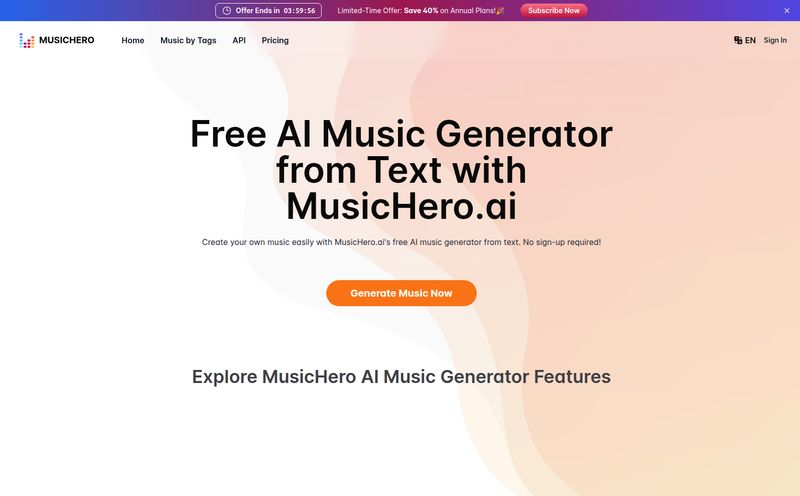If you’re a content creator, you know the pain. That gut-wrenching, soul-crushing search for the perfect piece of background music. You spend hours scrolling through stock music libraries, listening to tracks with names like “Uplifting Corporate Anthem #42,” only to find the one you like costs a small fortune or isn't quite right. I’ve been there. More times than I care to admit. It's a special kind of purgatory for anyone working with video, podcasts, or ads.
So when the buzz around AI music generators started getting louder, my ears perked up. We’ve seen AI write articles and create stunning images with tools like Midjourney. Music felt like the next, and perhaps most personal, frontier. Enter Udio. The name has been popping up in my feeds, promising to create any song I can imagine, just by describing it. Skeptical? Always. Intrigued? Absolutely. So I cleared my schedule, grabbed my best headphones, and dove in.
So, What Exactly is Udio?
In the simplest terms, Udio is an AI music generator. It’s part of a new wave of creative AI tools that feel like something straight out of science fiction. The core idea is beautifully simple: you give it a text prompt describing the music you want, and it… well, it makes it. We’re not talking about stitching together pre-made loops here. We’re talking about generating original melodies, harmonies, vocals, and instrumentation from scratch, in seconds.
You can be vague—“a sad piano melody”—or you can get ridiculously specific—“A 90s alternative rock anthem about a lost astronaut, with a driving bassline, female vocals, and a guitar solo.” It’s like having a team of infinitely patient session musicians on call 24/7, ready to try out your weirdest ideas.
My First Tune: A Test Drive into the Unknown
For my first experiment, I decided to go for something I could never find in a stock library. My prompt was: “A funky, upbeat soul track about the joy of finding the last good avocado at the grocery store, with a slap bass and brass section.”
I hit ‘Create,’ half expecting a robotic mess. Thirty seconds later, I had four different 33-second clips to listen to. And honestly? I was floored. One of them was an absolute banger. The bassline was groovy, the horns had punch, and the AI-generated male vocalist sang with a surprising amount of soul about the triumph of produce shopping. It wasn’t perfect—the lyrics were a little on-the-nose—but it was a real song. And it was mine.

Visit Udio
From there, I went down the rabbit hole. I made sea shanties about SEO, lo-fi beats for late-night work sessions, and even a ridiculously dramatic orchestral piece for my cat’s morning entrance into the living room. It's addictive.
The Good, The Bad, and The AI-Generated Ugly
After the initial novelty wore off, I started looking at Udio with a more critical eye. Like any tool, it has its brilliant moments and its… quirks. Let's break it down.
Where Udio Really Shines
The biggest pro is the sheer accessibility. You don’t need to know a single thing about music theory. You just need an idea. This opens up musical creation to a whole new audience. The speed is also a massive win for anyone on a deadline. Need a custom track for an Instagram Reel in five minutes? Done. The versatility is also impressive. I threw everything from German Polka to Hyperpop at it, and it rarely failed to produce something recognizable and often, pretty darn good. But for me, the real power lies in the editing features on the paid plans. You can take a 33-second clip you like and extend it, remix it, or even ask the AI to re-generate just the vocals. This takes it from a simple generator to a genuine creative partner. And the ability to export stems for use in a proper Digital Audio Workstation (DAW) like Ableton or Logic? That's a direct nod to serious producers, and it's a huge deal.
A Few Sour Notes
Of course, it's not all perfect. The quality of your song is entirely dependent on the quality of your prompt. Vague prompts lead to generic music. You have to learn how to “speak” to the AI, which has a learning curve of its own. It's an art form, really. Then there’s the bigger, more philosophical issue. While the music can be technically impressive, it sometimes lacks a certain… soul. That unpredictable human spark. It can create a sad song, but can it truly convey heartbreak? Some might argue not. You are a director, not the musician, and sometimes the AI’s creative choices can feel a bit sterile or predictable. It's definately something to be aware of.
Let's Talk Money: Udio Pricing Breakdown
Okay, the fun part. How much does this magic cost? Udio has a tiered system that I think is pretty smart, catering to everyone from the casual tinkerer to the professional creator.
| Plan | Price (Monthly) | Credits / Month | Key Features |
|---|---|---|---|
| Free | $0 | 100 (10/day) | Great for testing, 33-second clips, limited generations. |
| Standard | $10 ($8 if annual) | 1,200 | Full-length songs, editing tools, stem exporting, cover art. |
| Pro | $30 ($24 if annual) | 4,800 | Highest priority queue, more concurrent generations, WAV downloads. |
My take? The Free plan is the perfect sandbox. You can generate up to 100 clips a month, which is more than enough to see if you like the tool. The Standard plan is the sweet spot for most content creators, bloggers, and YouTubers. The 1,200 credits are generous, and unlocking full-length songs and stem exports is the real prize. The Pro plan is for the power users: agencies, professional musicians, or anyone who needs a high volume of tracks and the best possible audio quality with WAV downloads.
Who is Udio Actually For?
I see a few key groups getting a massive amount of value from this.
- Content Creators & YouTubers: This is a goldmine. Imagine having a completely unique, copyright-safe soundtrack for every single video you produce. No more strikes, no more generic stock audio. It’s a game-changer for branding your channel’s sound.
- Marketers & Social Media Managers: Need a quick, catchy jingle for a TikTok or a social ad? You can generate dozens of options in the time it takes to brew a cup of coffee.
- Musicians & Producers: Don’t see this as a replacement; see it as a brainstorming partner. Stuck for a melody? Hum a tune to Udio (with audio input) or describe a vibe and see what it spits out. Use the stem exports to pull a cool bassline or drum pattern into your main project. It’s a fantastic tool for overcoming writer’s block.
- The Curious & Creative: Honestly, it's just plain fun. You can write a personalized birthday song for your mom, create a theme song for your D&D campaign, or just see what a “Gregorian chant mixed with 8-bit video game music” sounds like. (I tried. It was weirdly cool.)
The Bigger Picture: AI's March into the Music Studio
It’s easy to get caught up in the doomsday narrative: “AI is coming for musicians’ jobs!” I just dont see it that way. Did the synthesizer replace pianists? Did the drum machine make drummers obsolete? No. They became new instruments, new tools in the creative arsenal. I see Udio in the same light. It’s a new kind of instrument, one that’s played with words instead of fingers.
It democratizes creation, which is a powerful thing. But it won't replace the raw, visceral experience of a live concert or the intricate storytelling of a human songwriter pouring their life into an album. It's a different beast entirely. It’s a tool, and like any tool, its value is determined by the creativity of the person using it.
So, my final verdict? Udio is incredibly impressive. It's a powerful, fun, and genuinely useful tool that feels like a glimpse into the future of content creation. It's not perfect, but its potential is undeniable. If you've ever struggled to find the right music for a project, or if you're just musically curious, you owe it to yourself to give the free plan a spin. You might just be surprised by the music you have hiding in your imagination.
Frequently Asked Questions about Udio
- Is the music from Udio copyright free?
- This is the big question! Based on their terms and how these platforms typically operate, users on the paid subscription tiers (Standard and Pro) generally own the rights to the music they generate and can use it commercially. For the free tier, the usage rights are usually more restrictive, often for personal use only. Always, and I mean always, check the latest Terms of Service on their site before using a track in a monetized project.
- How much does Udio cost?
- Udio has a free plan with daily credit limits. Paid plans start at $10 per month for the Standard plan (or $8/mo if billed annually) and go up to $30 per month for the Pro plan ($24/mo annually), with each tier offering more credits and advanced features.
- Can I use Udio music in my YouTube videos?
- Yes, that's one of its best use cases! If you're on a paid plan, you should be able to use the music in your monetized YouTube videos without fearing copyright claims. It's a fantastic solution for creating a unique brand sound.
- How good is the audio quality?
- The quality is surprisingly high, even on the free plan. For professional use, the Pro plan offers WAV downloads, which is an uncompressed, high-fidelity audio format perfect for video editing and professional production.
- What is a 'stem export'?
- Stem exporting is a feature for music producers. It allows you to download the individual tracks of a song—like just the vocals, just the bass, just the drums, etc. This lets you import them into professional music software (a DAW) to mix, edit, and combine them with other elements.
- How does Udio compare to other AI music tools like Suno?
- While both are leaders in the text-to-music space, they have slightly different focuses. Both are excellent at generating full songs from prompts. However, Udio's interface, especially its 'Sessions' timeline editor and emphasis on stem exports, seems to cater a bit more towards creators who want to take the AI-generated content and refine it further in a more traditional production environment.



